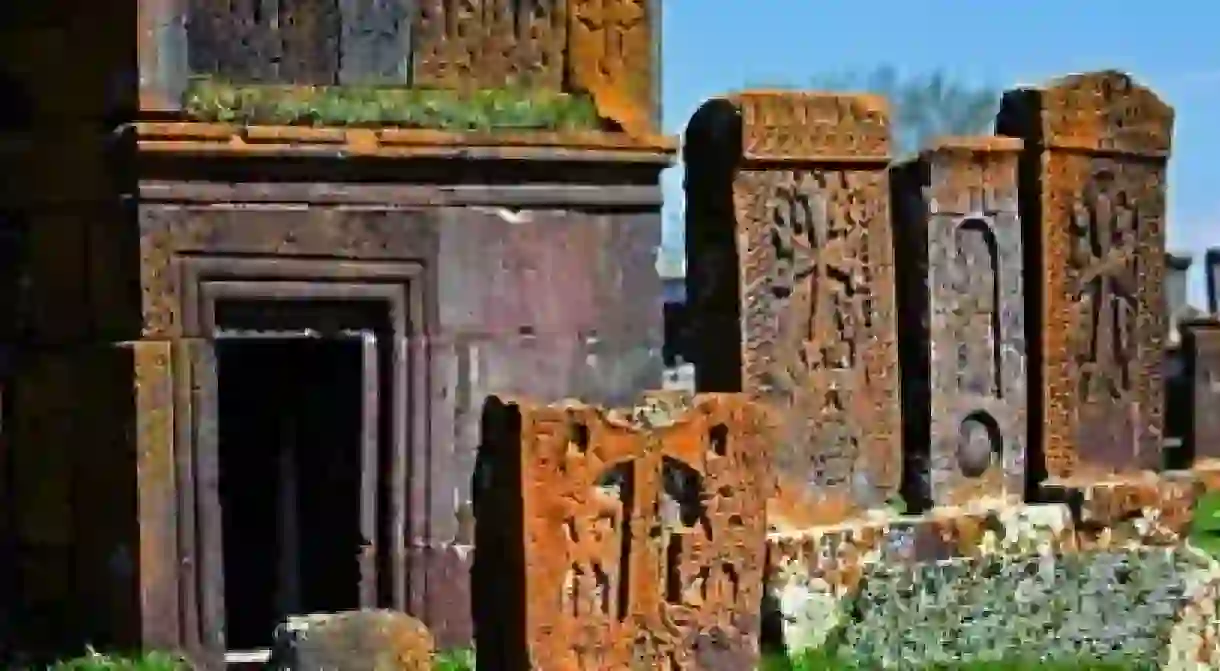The Khachkar: A Cornerstone of Armenian Identity

The cross is arguably the most familiar symbol of Christianity; but nowhere is this iconography as crucial or culturally entrenched as it is in Armenia. Wherever you go, thousands of khachkars, or cross-stones, pervade the conscience of the world’s oldest Christian nation, providing a rare glimpse into the art of spiritual expression.

The medieval monk Thomas à Kempis, on the subject of the Cross, once remarked, “In the Cross is salvation; in the Cross is life; in the Cross is protection against our enemies; in the Cross is infusion of heavenly sweetness; in the Cross is strength of mind; in the Cross is joy of spirit; in the Cross is excellence of virtue; in the Cross is perfection of holiness…”

With all these attributions, it is little wonder that the Cross could serve as a champion symbol of Armenian national identity and union. Starting from the 4th century, the conversion of Armenians, and the introduction of Christianity (and by extension, the Armenian Apostolic Church) as a state religion in AD 301, issued a new era of national consciousness. This burgeoning perception of Armenia as an entity distinct from the surrounding Zoroastrians was consolidated by several factors of the time: the invention of the Armenian alphabet, the effacement of the former pagan temples, and Gregory the Illuminator’s evangelical reign as the first head of the Armenian Church. The latter (now Armenia’s patron saint) particularly catalyzed the movement, and in an effort to distinguish and preserve the Armenian identity, ordered the creation of the first khachkar.
Upon initial inspection, the khachkar bears resemblance to other forms of Christian art, namely the Celtic High Cross and the Lithuanian Kryždirbystė. A type of relief sculpture, it features a variety of floral, vegetative, and geometric motifs, as well as tableaus of famous biblical scenes. Beautiful, yes — but in order to understand how a medieval stone became so charged with the Armenian spirit, a lesson in iconology is needed.
The cross was not always a well-esteemed symbol; it once represented the basest form of execution, reserved for the disgraceful. The resurrection of Jesus, however, and the persecution of the early Armenian Christians, transformed the cross into an image of soteriological victory: an emblem of triumph over the mortal vale.
At the same time, mountain worship was prevalent. The mountain, as a biblical location, connoted austerity, reverence, and closeness with God. Moses, for example, communicated with God through the Burning Bush on Mount Sinai. For the early Armenians, there was no better way to claim this new Christian heritage than through the mountains, with which their land was replete (Armenia’s ancient territory included several biblical mounts). Gradually, the mountain worship evolved into a stone stela that could be conveniently erected near the home or church.

When Gregory the Illuminator envisioned the khachkar, he believed it had the power to impart holiness into the air by sanctifying the immediate vicinity. Because religious and secular agendas were intrinsically at odds, the Cross, by virtue of the khachkar, was seen as a mediator between the Christian and the pagan. In turn, it began to assume various ecclesiastical functions – as gravestone, hallowed effigy, intervening spirit, talisman, and commemorative shrine of events, among others. Thus, it was only fitting that the khachkar turned into a uniquely Armenian fixture in graveyards, monasteries, cathedrals, residences, roadsides, and eventually, everywhere.
From an artistic perspective, the creative medium of rock boasts a powerful statement. Indeed, the rock has enjoyed several iconic references in the Bible. Jesus, in a famous discourse, quotes, ‘The stone the builders rejected has become the capstone’ and, at another time, tells Peter (petra being the Latin word for rock) that ‘…on this rock I build my church….’. Such strong imagery was necessary for the Armenian Church’s survival; qualities such as permanence, stability and grounded faith were perpetuated by the physical three-dimensional embodiment of the cross-stone. Of course, practicality would also play a huge role. Armenia, with its vast mountain ranges and dormant volcanoes, would have no trouble sourcing the slate and tuff, both relatively workable, for construction purposes. In a region prone to earthquakes, man-made structures would have to prove sturdy. The rock, as a substrate of spiritual expression, signified the eternal and the infinite, amidst an unpredictable future.

But the substrate, no matter how remarkable, is nothing without the craftsman. In the case of Armenians, anyone with religious and moral conviction could erect a khachkar. Moreover, khachkars were commissioned for a number of social, spiritual, or individual reasons – anything from the planting of a garden to victory in war. Some were dedicated to saints, but all were meant as a source of pride for the artist and the patron, the country, the church, and ultimately, God.
Today, that tradition continues. Using nothing but chisels and hammers, local craftsmen fashion out intricate designs in stone. Many of these master artisans, like Varazad Hambartsumyan, channel the spirits of their ancestors. ‘This is something our people have done for about 2000 years.’ Indeed, modern khachkars continue to feature ancient symbols and motifs such as the sun, the cross, and the wheel of eternity. Others depict saints and biblical imagery such as the dove and the grapevine. While there are many similarities, no two khachkars are ever alike, adding to their unique character. As Hambartsumyan shares, ‘Khachkar is a prayer, khachkar is a sacrifice, khachkar is our ancestors, khachkar is our identity.’
Connecting both the past and the present, the khachkar continues to watch over the world’s oldest Christian nation, making this unique art form a true Armenian cornerstone.













